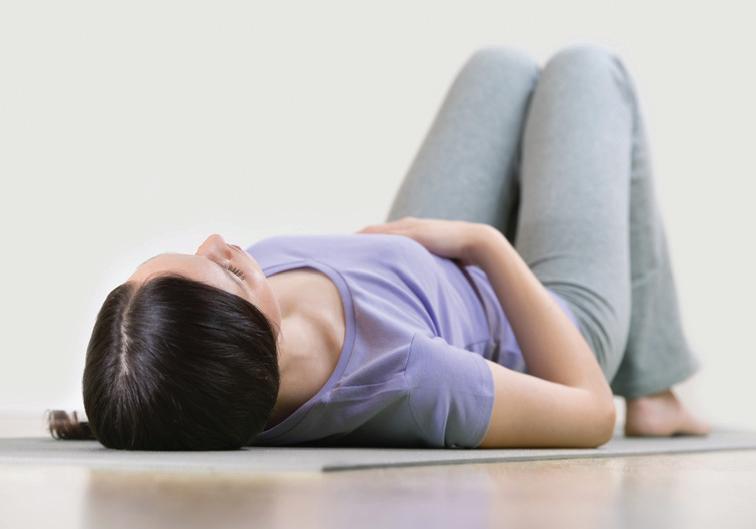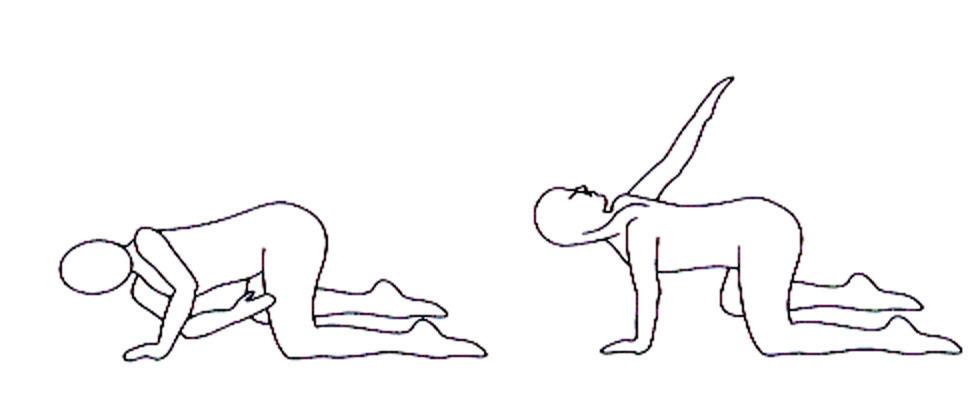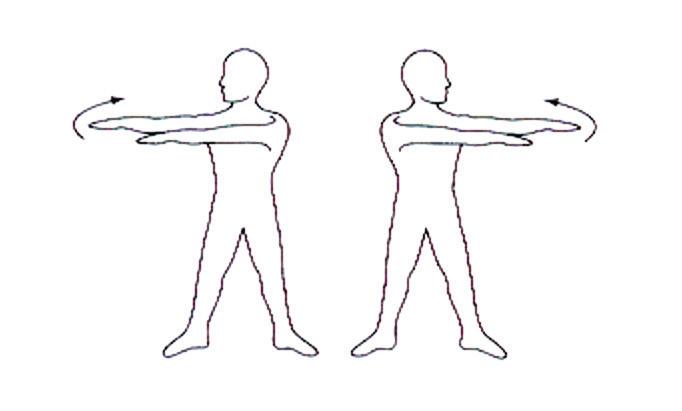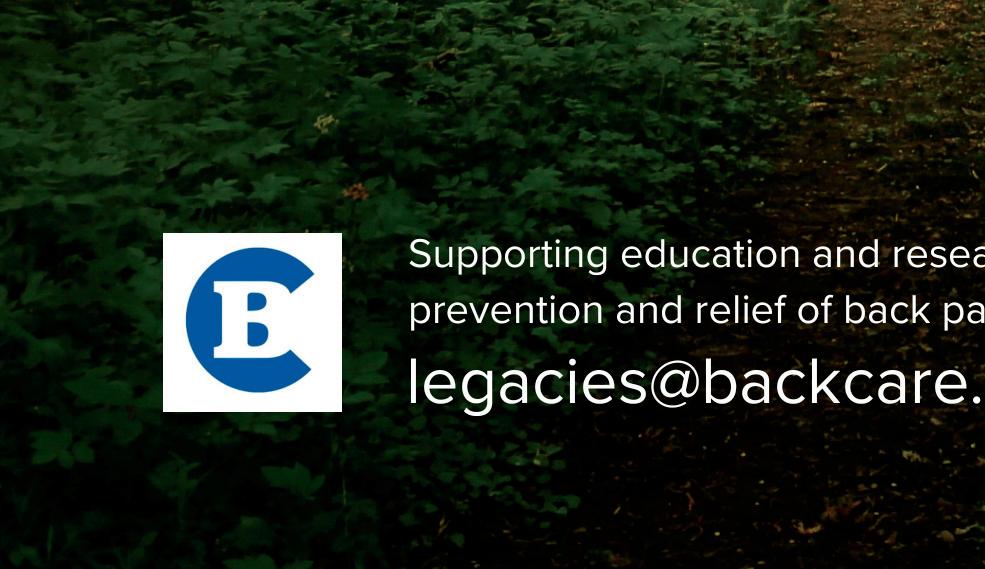




Back pain is now the world’s leading cause of human disability, affecting some half of the adult population in a given month and almost 80% of people at some point in their lives.
Being accountable for more than 12 million lost work days each year, in the UK alone, back pain is one of the biggest causes of workplace absence and costs economies worldwide billions of pounds annually.
Back pain is a pain. However, many people are unaware that the injuries behind back pain are often avoidable. Back care awareness is important for all of us, regardless of our age, whether we are in education, in employment or long into retirement. From cradle to grave it is important to protect our backs.
Take some time out to learn more about your spine and how you can sit, stand, lift or carry bags with your back in mind. Think too about how you can incorporate exercise and a healthy diet as part of your routine. We’ve got your back in order to help keep yours pain free. Start today.
For further information or to support our work: visit www.backcare.org.uk or email: info@backcare.org.uk
 The BackCare Team
The BackCare Team
Our spines are like a stack of cotton reels, with sponge-like cushions between them, all held together by tough fibrous material. The whole system functions as a strong yet flexible scaffold to which the rest of the skeleton ultimately connects. And, if this were not enough, the spine also supports and protects the body’s nerve impulses carried by the spinal cord. This bundle of nerves carries sensory input, received by the body, onwards to the brain and transmits instructions from the brain to all parts of the body.
This integrated, intricate structure is at the core of everything we do. It deserves to be well looked after.
In anatomy, the spine or backbone is known as the vertebral column. To explain our analogy, the cotton reels are known as vertebrae and are made of bone. Running through each vertebra is a hollow core (spinal canal) which houses the spinal cord. They have levers that allow, amongst other things, connection to adjacent vertebrae and control of joint movement.
Separating and connecting the vertebrae are the intervertebral discs. These “cushions” act as shock absorbers between the vertebrae and work by having a tough outer layer of collagen, anulus fibrosus that contains the inner, gel-like material, the nucleus pulposus. Each disc acts in a similar way to a tyre when put under load, distorting without rupturing thus allowing pressure to be distributed. When working normally, these discs contribute to pain free movement but damage to them or age-related degeneration can lead to misery for their owner.
The small holes between vertebrae allow nerves to spread out from the central spinal cord at different levels to all parts of the body.
These two components of the spine are bound together by ligaments which, through a complicated network of connections, turn these individual parts into a functioning backbone. The final piece of the puzzle is the support of elastic muscles (and connecting tendons) whose lengthening and shortening create movement and help to provide stability.
Many animals have a backbone, and are, therefore, classified as vertebrates. Very few of them walk upright on two legs as humans do. To perform this almost magical trick, our spines have evolved into an elongated “S” shape to improve
the stability of our movement.
The spine is spilt into five different sections according to their function, mobility and curvature: cervical, thoracic, lumbar, sacrum and coccyx. There are typically 7 vertebrae in the cervical spine, 12 in the thoracic and 5 in the lumbar all of which allow movement via the discs, articulations and ligaments and by the action of muscles (and connecting tendons) on them. The sacrum and the coccyx both contain fused vertebrae.

The cervical spine, with an outward curve (convex), starts deep in the skull, allowing rotation of the head via the special C1 (Atlas) and C2 (Axis) vertebrae, extending downwards into the neck. The thoracic spine is more rigid and provides the connection point for ribs with the curve snaking inward (concave). This gives way to the lumbar spine where the curve returns to a convex shape, something which is more pronounced in women. Finally, the fused sacrum and coccyx form a smaller concave curve.
Importantly, there is more movement within the cervical and lumbar sections leading to increased risk of injury to these areas through mistreatment.
There are many different causes of back pain ranging from acute injury to degenerative conditions.
Back pain can range in intensity from a dull, constant ache to a sudden, sharp or shooting pain.

The spine is one of the most important structures in the body - it helps to keep you upright, supports your entire body and allows a range of different movements. Almost every task we complete daily involves moving our backs.
A healthy spine prefers regular movement to static positions, and likes frequent changes of position as opposed to repetitive actions. Movement is also needed to increase blood flow which helps to remove the build-up of toxins and nourish the spine.
Most back pain is caused by sprains, strains, lack of physical activity and posture problems rather than spinal damage or other health conditions. Non-specific back pain can be split into two types: short term pain, also known as acute, which lasts a few days to a few weeks, but usually less than six; and chronic pain which is defined as back pain that lasts longer than 12 weeks.

Whilst everyone is susceptible to back pain, the following factors can all contribute to your risk of back pain and injury.
Do you:
Work in unbalanced or top • heavy positions?
Undertake heavy lifting, • handling, or forceful exertion beyond your own capability?
Get into poor postures that • are prolonged or frequent? For example, stooping, side bending and twisting of your back and neck. The longer you stay in these positions, the greater your risk of injury.
Hold loads or work with your • arms away from your body?
Are you:
•
•
Affected by a previous injury?
Generally unfit?
Feeling stressed or suffering
• low moods?
Not getting enough breaks,
• rest and sleep?
•
Additionally, certain lifestyle factors are associated with an increased risk of back pain. Being overweight, obese, or rapidly gaining significant amounts of weight can put stress on the back. Smoking can restrict blood flow and oxygen to the discs, leading to faster degeneration.
Watch out for the following signs which may be indicative of ‘back trouble’:
Sudden shooting pains or leg
• pains
Numbness or pins and needles
• in both arms, both legs or around the anus (bottom)
Reduced muscle power,
• particularly through one side
Sudden and unexpected
• bladder, bowel or sexual dysfunction
Look out for these warning signs and take them seriously. Get an expert opinion - see your GP, physiotherapist, chiropractor or osteopath. In emergencies call NHS 111.
Not drinking enough water?
The list of complaints related to structural back problems in adults includes (but not restricted to) arthritis, fractures and decreased mobility. Correcting a structural back problem is often very complicated, just as correcting a posture can be. Medical communities and allied health care professionals all agree; prevention really is better than cure.
Whilst for short periods of time, poor posture poses little need for concern, in the longer term this can lead to potentially debilitating, musculoskeletal injury including back pain.

A healthy spine from the side looks like a letter ‘S’ with three curves, rather than a curved and damaging ‘C’ shape. From behind, a healthy spine is straight upright
- it is important to remember this throughout our daily activities whether that be walking, standing or sitting. Ideally, you should spend as much time as possible in a neutral posture. This means a comfortable body position in which no body part is awkwardly twisted or bent around.
When you lean forward, the lumbar spine bends out. This is known as kyphosis and puts increased pressure on the intervertebral lumbar discs. When sitting for prolonged periods, it is important to sit in a way such that the natural lordotic curve (the inward curve) of the lumbar spine is supported. When you sit back, your lower back curves towards your abdomen. This is known as lordosis. As well as being the most relaxed posture for the lower back, it also puts the least pressure on the intervertebral discs.
Use these tips to help position yourself in your chair if you are sitting when working or reading:
Ears are over your shoulders
rather than in front of your shoulders
Sit all the way back in your • chair, focusing on making your spine as long and straight as it can be

Ensure your hips are at a 90 • degree angle (or slightly more, if possible) with a small gap between the front of the seat and the back of your knees. This helps to maintain the natural curve in your lower back
To create better support for • your lower back, place a small cushion or rolled up towel in the small of your back
Elbows are by your sides • with your wrists resting comfortably on a round or soft surface
Ensure your knees are at a 90 • degree bend and your feet are on a flat surface. If they don’t reach the floor comfortably, use a footrest or stack of books
Adjusting your screen to an appropriate height will assist you in maintaining a good posture. Ensure you are not having to look up or down at your screen, and place your screen directly in front of you so you are not having to twist your neck to look at it. For most people,
the screen will need to be raised anywhere between 5 and 10 inches in order to provide the proper height. If using a laptop, this can be achieved with a stack of books or board games if you do not have a proper stand. In this case, it is important to use a separate mouse and keyboard to ensure proper wrist positioning. The palm of your hands should be parallel to the keyboard, your forearms horizontal, wrists flat, and your elbows at 90 degrees, level or slightly higher than the keyboard.
Your keyboard and mouse should be about 8cm to 10cm from the edge of your desk to allow room to rest your wrists when not typing. Use a soft touch and spread the keyboard work between both
hands.
Additionally, your screen should be roughly arm’s length away to ensure the correct viewing distance. If possible, choose a large screen and set the level of zoom such that you can read documents without having to lean forward.
If you are able to purchase and have the space for an adjustable chair, it will provide additional support for your back and allow some movement so that you are not in one fixed position. It is important to remember that there is not one perfect chair for everyone, but some important points to consider when purchasing an office chair are:
Is the chair stable such that it • will not topple or collapse?
Does the chair allow you easy • freedom of movement?
Is the chair fully adjustable, • including the armrests?
Ideally, the chair should tilt • forward (the part you sit on) as this takes the strain off your spine (conversely, a chair that tilts backwards is bad)
A range of additional supports such as lumbar rolls are widely available and can be used to increase comfort.
Always think about your posture. For example, pinning a phone between your ear and shoulder while you continue to type can cause unnecessary stress to your back due to the awkward positioning of your neck. Instead, put your phone on speaker or use a headset.
Wherever possible, avoid working on your bed as this is even worse for you than a fixed chair. Unless you sit on the side of your bed, your legs will be crossed or extending horizontally, acting as support for your laptop. This is far too low for optimal screen viewing and so you will be hunched over.
Sit so you are well supported - • your back should be touching the chair rest
Avoid chairs and sofas which • are too low, deep, soft or angled backwards
Whenever you are sitting • anywhere, your knees should be lower than your hips
Make sure your lower spine is • supported by sitting back as far as possible. Consider using a lumbar roll, or rolled towel, behind your lower back for additional support
Avoid propping your feet up • on a coffee table or stool such that your knees are straight. Instead, place both feet on the floor or ensure your knees are slightly bent when elevating your legs
Avoid non-symmetrical and • unsupported positions such as side-lying with your head on a cushion and your neck “crooked” to one side
If you are watching TV, try and • have the set directly in front of you so you don’t have to rotate your neck or back to see the screen
Sitting in a cross-legged • position causes us to lean our body forward. This should be avoided as much as possible. If you do like sitting cross legged, make sure you sit back into the sofa so that your buttocks and lower back are well supported or place a cushion at the small of your back to encourage a more neutral spine position
Even if you were to maintain a perfect posture for the whole day, you could still end up with a sore back from a lack of variability in movement. Therefore, the most important thing to remember when sitting on a chair all day is to get up regularly to move and stretch as this will prevent your muscles staying in the same position for too long. This causes them to tire and the consequence of this can be back pain.
Even 30-second “microbreaks” to change your posture briefly by standing up or arching your back a few times while seated can help take pressure off.
Try to change your position at least every 20 minutes - if you are sitting down, stand up, walk about and

stretch with these simple pause gymnastics throughout the day. Repeat each one 5 times.
Pull your chin in, turn your • head slowly from side to side. Relax
Raise your shoulders up to • your ears, hold, push them back. Relax
Tighten your tummy muscles • and breathe out slowly.
Release
Stand tall with your feet • slightly apart and knees slightly bent. Place your hands in the small of your back, push your hips forward and shoulders back. Count to five.
Release
Try to take a break in the middle of the day for 15 to 30 minutes to exercise. Think of ways to vary your movement - you could go for a 30minute walk or you could do some exercises such as jumping jacks, pushups, or situps to improve your circulation.
If you are short on time, you could do some simple stretches such as:
Shoulder shrugs • - gently raise and lower your shoulders
Shoulder blade squeezes •sit straight and squeeze your shoulder blades inwards at the back. Hold for 5-6 seconds before relaxing
Chin tucks
• – bring your chin backwards to straighten your neck without looking down
Side bends • - stand straight with your feet shoulder-width apart. Bend to your right side and remain in that stretch for about 5-6 seconds. Come to the original position and bend to your left side
Seated calf raises
• - raise your heels and hold for three seconds
Resisted arm curls
• - gently raise your lower arm against downward pressure from your other arm
Wrist rolling • - flex, stretch and roll your wrists
Hand/finger exercise
• - turn your head left and right and hold for a count of three in each position
Lateral neck rotations
• - place an elastic band around your fingers and stretch your fingers against the resistance of the elastic band
Repeat these exercises 10-15 times in two sessions throughout the day.
Breathing properly leads to relaxation of the body, including the muscles in the mid and lower back. Breathing exercises can be a way to target lower back pains. These exercises can be done anywhere and anytime. All you need to do is concentrate on your breathing. Inhale and try bringing your navel towards your spine and then exhale. This breathing exercise will engage your core muscles and it will support your upper body.
The intervertebral discs are filled with a substance which is mainly composed of water. These discs act as shock absorbers and prevent the bones from rubbing against one another. Walking, sitting and standing all put pressure on the
spine, causing the vertebrae to continually squeeze the discs, which could contribute to reduced water content. It is believed that if we are not constantly replenishing the lost water, the discs could deflate slightly or, at worst, the walls could begin to dry and crack which makes them weaker. Regardless, staying hydrated is therefore particularly important for general health - aim to drink at least two litres of water a day. If you don’t like water alone, try flavouring it with some fresh lemon or lime, but don’t use sugary drinks in place of water.
Hydration is ever more important as we age - over 60% of people exhibit disc degeneration after the age of 40. The complicated

chemical process that allows water to migrate to the nucleus pulposus no longer works as well in later life leaving the disc less able to absorb shock and at higher risk of tearing (herniation).
Many people living with back pain will find that there are some relatively common causes of their discomfort. What may surprise people with back problems is that diet, and maintaining a healthy weight can play a major role specific to back health - including the preven on of many problems
and improved healing in the case of injury.
The bones, muscles and other structures in the spine need balanced nutrition so they are strong enough to support the body and to perform their other functions. Eating a balanced diet with the right amount and variety of vitamins and nutrients can reduce back problems by nourishing the bones, muscles, discs and other structures in the spine.
Whilst being overweight will not necessarily be the only cause of back pain, it can be a contributory factor - adding to wear and tear that is already present whilst also hastening or worsening underlying disorders. Excess weight can do our spines little good and exerts abnormal pressure on back muscles. Whilst exercises designed to strengthen the lower abdominal muscles may help, importantly, the loss of weight is key to relieving the strain on the back and spine.
A diet high in fat and calories almost always leads to weight gain and can therefore cause or increase physical stress on the spine. A healthy diet, encompassing vitamins and minerals found in dietary supplements or found in

naturally leafy greens, citrus fruits, fish, nuts, seeds, pulses and some meats can all play an important role in reducing or preventing spine pain.
For most people, incorporating a new habit or getting rid of harmful practices takes approximately one month. People who gradually replace fatty and processed foods with healthier choices are more likely to enjoy long-lasting changes, and progressively losing weight can relieve pressure from the lower back.
A well-balanced diet can also reduce the risk of injury to the spine from falls. For instance, a vitamin D deficiency can make the spinal cord increasingly prone to injury with age. Additional dietary essentials that may prevent spine pain and discomfort include:
Vitamin A – Repairs tissues • supporting the spine
Vitamin B12 – Promotes • healthy bone marrow within the spine
Vitamin C – Promotes healing
• of injured ligaments, tendons, and vertebral discs
Vitamin K – Allows the spine to • properly use calcium
Iron – Assists with the • production of myoglobin, which promotes healthy spine muscles
Magnesium – Helps maintain • bone density and muscle tone that can prevent back problems
The good news is that it’s never too late to make dietary changes to promote optimal spine health.
Exercise is commonly advised as one of the best ways to both prevent and manage most back pain as it strengthens muscles which can help protect your back.
Furthermore, a sedentary lifestyle is one of the leading risk factors associated with chronic diseases and preventable deaths. The risk can be modified by reducing the hours spent sitting per day and increasing the hours spent exercising per week.
It is recommended that you take part in 150 minutes of moderate intensity activity a week or 75 minutes of vigorous intensity activity a week.
There are a huge range of exercises, sports and activities you can do. The most important thing is
choosing something enjoyable as you are more likely to exercise regularly.
You do not have to do them all in one day, it is best to spread them over the week.
Remember that you only get the benefits of exercise if you do it regularly. It is also important that you increase your level of activity gradually, doing a little often rather than occasional bouts of intense activity.

Some exercises such as swimming, Pilates, hydrotherapy and walking are popular among people with back pain, but there is no concrete evidence that any one type of exercise is better than another. If you find that one exercise makes your back pain worse, adapt it or choose a different one.

There are three different types of exercises: strength, endurance and flexibility. These are all important when staying fit and healthy so choose an exercise programme that includes all these types of exercise.
There are also some exercises you can do on your own at home without specialist equipment that can help to strengthen your back and prevent and ease back pain: Please note that the following exercises are intended to help strengthen core muscles. You should seek advice from a registered medical practitioner for examples of specific exercises that will benefit a particular condition.
Stand with your feet slightly apart and arms folded in front of your chest

Stand with your feet apart and arms folded in front of your chest
Bend your knees a little and bend your hips to get your back flat and parallel to the ground while sticking your bottom out
Breathe out on the way down, in on the way up
Repeat 10 times
While on the floor on all fours raise one hand off the floor and reach underneath your body as far as you can
Bend your knees until your thighs are halfway to being parallel with the ground (one third squats) Return to the upright position


Progress to having your thighs parallel to the ground (half squat) but never deeper
Breathe out on the way down, in on the way up
Repeat 5 times (gradually increase to 10)
Start with feet hip width apart, hands and arms reaching directly forward at shoulder level
On the return, swing the arm out to the side as far as you can, then return to the starting position. Follow the moving hand with the eyes

Repeat with the other arm
Repeat 10 times
Turn your head, arms and shoulders around to the left as far as you can go, bending the right arm across the chest, keeping your hips still
Repeat to the right
Repeat 10 times.
Standing with your feet hip width apart, arms at your sides, bring your hands up to just below your chin

On the floor, on all fours, place your hands shoulder width apart and your knees slightly apart (arms and thighs should be vertical)

At the same time bringing your elbows up as far as possible to the side of the head
Return your arms to your sides breathing in on the way up, out on the way down
Repeat 10 times
While in the all fours position draw alternate knees to the opposite elbow


Stretch one arm forward in front while stretching the opposite leg out behind
Repeat 10 times (each side)
Arch the back, at the same time, look down at the floor
Return to the original position
Repeat 10 times (do the same with the other leg)
Then lower the stomach towards the floor, hollowing the back while looking up
(If you are pregnant you should not do the second part of this exercise instead keep your back straight)
Repeat 10 times
Position yourself on the floor on all fours
Swing your bent leg out to the side from your hip then return it to the middle
Repeat 10 times (do the same with the other leg)
Sitting cross legged, twist your shoulders around and place your right hand on the floor behind you
Keep your pelvis on the floor and only raise your back
Repeat 10 times
Research has shown that the most important muscles supporting your back are the deep abdominal or ‘core’ muscles. These muscles are like a ‘corset’ around your lower trunk.
Place your left arm outside of your right knee and twist towards the right, holding for five seconds, using your left arm as a lever against the knee

Repeat five times (each side)
Lying face down on the floor, with your hands placed below your shoulders, push up with your arms
Your core muscles therefore need to be strong and supple in order to support your spine and take pressure off your lower back. Unfortunately, for most of us, our core muscles are rarely used enough during everyday activities. These muscles need to be toned through specific, targeted exercises.
Try the following exercise when sitting, standing or lying on a firm surface with your knees bent up


Breathe normally and draw
• your navel gently in towards your spine
Pull the pelvic floor muscles
• (between your legs) up at the
Try to hold in your muscles for • up to 10 seconds then release
Once you can hold these muscles in when still, try holding them in whilst moving around. For example, when out walking or doing the house work. Even just sitting or standing with good posture can help these muscles to work correctly.
Manual handling occurs in practically every workplace and encompasses everything from lifting and supporting a load through to transporting the load by pushing it, pulling it, carrying it or moving it in any other way that requires physical effort.
Common injuries range from pulling a muscle to damaging tissue, trapping a nerve, crushing vertebrae or causing a hernia. Most injuries are to the back, but hands, arms and feet are also vulnerable to fractures and lacerations. Always consider four things in your risk assessment – Task, You, Load and Environment
Does the task involve twisting, stooping, bending, excessive travel, pushing, pulling or precise positioning of the load, sudden
movement, inadequate rest or recovery periods, team handling or seated work?
Are you the best person for the job considering health, pregnancy, age etc.?
Is the load heavy, unwieldy, difficult to grasp, sharp, hot, cold, difficult to grip or are the contents likely to move or shift?
Your Environment. Are there space constraints, uneven, slippery or unstable floors, variations in floor levels, stairs or steps, doors to open, extremely hot, cold or humid conditions, poor lighting, poor ventilation, gusty winds, clothing or Personal Protective Equipment that restricts movement?
How can you reduce the risk? Think before you lift:
Avoid lifting and handing, by • using automation
Use a lifting aid and make sure • these are maintained in full working order Reduce
If at work, make sure you have
• been trained in correct lifting and handling techniques
Consider storage height of • items to be lifted – lifting below knee height or above shoulder height puts increased strain on the spine
Wear suitable attire, such as • steel toe capped boots and gloves (but ensure these don’t restrict movement)
If you are going to lift:
Keep the load close to your • waist
Adopt a stable position •
Ensure a good hold on the • load
At the start of the lift, • moderate flexion (slight bending) of the back, hips and knees is preferable to fully flexing the back (stooping) or the hips and knees (squatting)
Don’t flex your spine any • further as you lift
Avoid twisting the trunk or • leaning sideways, especially while the back is bent
Keep your head up when • handling
Move smoothly •
• easily manage
Don’t lift more than you can
Moving and handling assistance is helping a person to help themselves or moving someone who cannot help themselves, without taking all or most of their body weight. Lifting is when someone cannot help and all or most of their body weight is being taken.
Before assisting anyone to move, think carefully about what you are about to do and how best to go about it.

Consider: The activity
Can it be avoided or the effort • involved reduced?
Could the person you care • for do it themself with encouragement?
Is there equipment available • that would help?
What is the best way of doing • the activity?
Where are you moving them • to?
Yourself and others helping
What is your own personal • ability? Are you sure that you can do it?
Do you need help from • another person?
If you have help, plan the • move together, decide who is to take the lead.
Are you wearing clothes • that are easy to move in and supportive footwear?
The person being assisted
What are they like? How do
• they like to do things?
How much can they help? •
• operate?
How much can they co-
Do they have trust in the way
• you move and assist them?
Can they move themself
• with verbal prompts or with equipment?
Are they in pain? Can they
• have painkillers before you move them?
Do they get tired? Can they
• rest before moving or wait until more help is available?
Are there any attachments,
• such as catheters, that must be secured before they are moved?
Do they often fall? Do you
• know why and how to deal with this?
Is the person well enough to
• get out of bed or be moved?
If you are not sure, it is safer to leave them where they are.
The environment – think about the surroundings and any equipment.
Is the area free from clutter
• and obstacles?
•
Is the floor dry, not slippery?
Have any trip hazards like
• loose rugs been removed?
Are there pets or children in • the way?
Have the bed and chair or • other working surfaces been raised to a suitable height if possible?
Is equipment at hand, safe to
• use and brakes applied where appropriate?
Stay active; bed rest will not
• cure back pain
Local application of heat • or cold (by preference) can be effective at reducing discomfort
Even after the pain has
• disappeared, stay active, exercise regularly and look after your back to prevent the pain recurring
Most back pain problems start for no obvious reason. The spine is strong and back problems are rarely due to a serious illness or damage.
Back problems can cause a range of symptoms including:
Hot, burning, shooting or
• stabbing pains in your back and sometimes in one or both of your legs
Pins and needles due to nerve
• irritation
In many cases, a new or flare-up of a long-standing back problem should begin to settle within 6 weeks, without the need to see a healthcare professional.
However, speak to a healthcare professional as soon as possible if you feel:
•
Generally unwell
Have back pain that has
• started when you are ill with other problems - such as rheumatoid arthritis or cancer
Feeling unsteady when you
• walk
Your back pain has lasted for
• longer than 6 weeks
If you have symptoms that are very severe, for example numbness or weakness in the legs, phone 111, or visit your nearest A&E department, without delay.
Stiffness
• Muscle spasms
•





